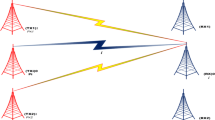Abstract
In MIMO systems the antenna array configuration in the BS and MS has a large influence on the available channel capacity. In this paper, we first introduce a new Frequency Selective (FS) MIMO framework for macro-cells in a realistic urban environment. The MIMO channel is built over a previously developed directional channel model, which considers the terrain and clutter information in the cluster, line-of-sight and link loss calculations. Next, MIMO configuration characteristics are investigated in order to maximize capacity, mainly the number of antennas, inter-antenna spacing and SNR impact. Channel and capacity simulation results are presented for the city of Lisbon, Portugal, using different antenna configurations. Two power allocations schemes are considered, uniform distribution and FS spatial water-filling. The results suggest optimized MIMO configurations, considering the antenna array size limitations, specially at the MS side.
Similar content being viewed by others
References
Foschini G. J., Gans M. J. (1998) On limits of wireless communications in a fading environment when using multiple antennas. Wireless Personal Communications 6: 311–335
Telatar, E. (1995). Capacity of multiantenna gaussian channels. AT&T Bell Laboratories, Technical Memorandum.
Cover T.M., Thomas J.A. (1991) Elements of information theory. Wiley, New York
Vieira, P., & Queluz, M. P., Rodrigues, A. (2007). Terrain and clutter impact on joint statistical properties of azimuth spread and delay spread in macro-cell bad urban environment. In Proceedings of IEEE international symposium on wireless communication systems 2007 (pp. 798–802). Trondheim, Norway.
Vieira, P., Queluz, M. P., & Rodrigues, A. (2007). Clustering of scatterers over an irregular clutter environment: An extension of cost 273 mimo channel model. In Proceedings of 66th IEEE vehicular technology conference fall 2007 (pp. 824–828). Baltimore, USA.
Vieira, P., Queluz. M. P., & Rodrigues, A. (2007). A dynamic propagation prediction platform over irregular terrain and buildings for wireless communications. In Proceedings of 66th IEEE vehicular technology conference fall 2007 (pp. 884–888). Baltimore, USA.
Vieira P., Vieira M. A., Queluz M. P., Rodrigues A. (2007) A novel vehicular mobility model for wireless networks. Wireless Personal Communications Journal, Springer 43: 1689–1703
3GPP. (2007). Spatial channel model for multiple input multiple output (mimo) simulations. 3GPP TR 25.996 V7.0.0.
Andreas F.M. (2005) Wireless communications. Wiley, New York
Jakes W. C. (1993) Microwave mobile communications. IEEE Press, Piscataway, NJ
Vieira, P., Queluz, M. P., & Rodrigues, A. (2007). An improved directional channel model over irregular terrain and clutter. In Proceedings of 10th international symposium of wireless personal multimedia communications 2007 (pp. 523–527). Jaipur, India.
Andersen J. B. (2000) Array gain and capacity for known random channels with multiple element arrays at both ends. IEEE JSAC 18(11): 2172–2178
Kermoal J. P., Schumacher L., Pederson K. I., Mogensen P. E. (2002) A stochastic mimo radio channel model with experimental validation. IEEE JSAC, Special Issue on Channel and Propagation Models for Wireless System Design 20(6): 1211–1226
Almers, P., Tufvesson, F., Edfors, O., & Molisch, A. F. (2002). Measured capacity gain using water filling in frequency selective mimo channels. In The 13th IEEE international symposium on personal, indoor and mobile radio communications, 2002, 3, 1347–1351.
Author information
Authors and Affiliations
Corresponding author
Additional information
Corresponding author e-mail address is available for all problems and questions.
Rights and permissions
About this article
Cite this article
Vieira, P., Queluz, P. & Rodrigues, A. Capacity Enhancement Using MIMO Antenna Arrays in Realistic Macro-Cellular Urban Environment. Wireless Pers Commun 55, 201–224 (2010). https://doi.org/10.1007/s11277-009-9795-z
Received:
Accepted:
Published:
Issue Date:
DOI: https://doi.org/10.1007/s11277-009-9795-z





